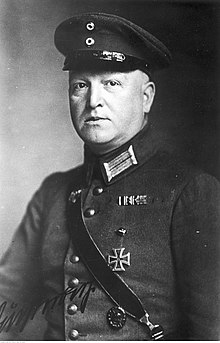Theodor Duesterberg
Theodor Duesterberg | |
|---|---|
 Duesterberg in uniform, ca. 1932 | |
| Deputy Federal Leader of Der Stahlhelm | |
| In office 9 March 1924 – 21 June 1933 | |
| Personal details | |
| Born | 19 October 1875 Iron Cross First Class |
Theodor Duesterberg (German pronunciation:
Background
Born the son of an army surgeon in
Der Stahlhelm
After various disagreements with the party leadership, however, Duesterberg left the DNVP in 1923 and joined the nationalistic and pro-monarchy Der Stahlhelm, which largely consisted of ex-servicemen disgruntled with the Weimar Republic. Duesterberg quickly moved through its hierarchy and by 1924 was one of two of its federal leaders (the other being Franz Seldte). Together with General Georg Ludwig Rudolf Maercker, Duesterberg was one of the leaders of the extreme anti-Semitic faction within Der Stahlhelm who wanted to ban Jews from joining, and expel all of the current Jewish members.[2] In March 1924, Maercker and Duesterberg forced Seldte to adopt the "Aryan clause" and expel all Jews from Der Stahlhelm.[3] The "Aryan clause" of 1924 was later to serve as the inspiration for similar "Aryan clauses" under the Third Reich, and in particular influenced the War Minister, General Werner von Blomberg in his attempts to keep the Wehrmacht "racially clean".[4] Under Duesterberg's leadership, Der Stahlhelm became Germany's largest para-military group.
In the late 1920s, Duesterberg allied Der Stahlhelm with the
1932 presidential election

In 1932, Duesterberg was nominated by Der Stahlhelm and DNVP to run for
- That Der Stahlhelm members present notarized copies of church records proving that their parents, grandparents and great-grandparents had no "Jewish blood".[8]
- That Der Stahlhelm members swear on their word of honor that they had no personal, familial or business dealings with Jews in any form or way.[8]
- That Der Stahlhelm members present proof that their ancestors had fought in the "wars of liberation" against Napoleonic France and/or the wars of unification and on what side.[8]
- That Der Stahlhelm members present proof that they had fought in the World War and in what capacity.[8]
The revelation of Duesterberg's Jewish ancestry caused Duesterberg to poll poorly in the first ballot of the election, and he withdrew from the runoff election that followed.[1]
During the 1932 presidential elections, the Nazis went out of their way to taunt Duesterberg for having Jewish ancestry with Joseph Goebbels and Richard Walther Darré being especially vicious in their attacks. Duesterberg was so hurt by Darré's attacks that he challenged him to a duel, a challenge that Darré rejected because it was beneath him to fight a man with "Jewish blood". Duesterberg then took up his dispute with Darré before the court of honor of the Former Officers of the 1st Hanoverian Field Artillery Regiment of Scharnhorst, number 10 to which Darré belonged. Duesterberg argued before the court of honor that Darré should be expelled for engaging in behavior that was unbecoming of a German officer while Darré argued that he had right and duty to subject Duesterberg to anti-Semitic insults. The court of honor ruled in Darré's favor, stating that he was right to insult Duesterberg for having "Jewish blood".[8]
Ironically, Duesterberg was offered a position in Hitler's cabinet when Hitler became
Arrest and later life
In 1934, Duesterberg was arrested by the Nazis during the
References
- ^ ISBN 0-415-26038-8.
- ^ Wette 2007, p. 63.
- ^ Wette 2007, pp. 63–64.
- ^ a b Wette 2007, p. 64.
- ^ Jones, Larry Eugene "Nationalists, Nazis, and the Assault against Weimar: Revisiting the Harzburg Rally of October 1931" pages 483-494 from German Studies Review Vol. 29, No. 3, October 2006 page 485.
- ^ Jones, Larry Eugene "Nationalists, Nazis, and the Assault against Weimar: Revisiting the Harzburg Rally of October 1931" pages 483-494 from German Studies Review Vol. 29, No. 3, October 2006 pages 485-486.
- ^ "Duesterberg, Stahlhelm Leader, Candidate for President, Says He is of Jewish Origin". Jewish Telegraphic Agency. 7 September 1932. Retrieved 15 July 2018.
- ^ a b c d e f Wette 2007, p. 65.
- ^ "Duesterberg, Steel Helmet Leader, Ousted for Jewish Descent". Jewish Telegraphic Agency. 28 April 1933. Retrieved 15 July 2018.
Further reading
- ISBN 9780674025776.
